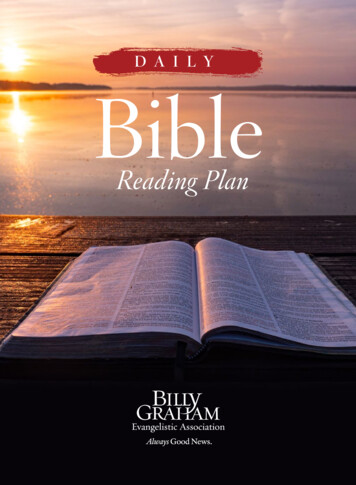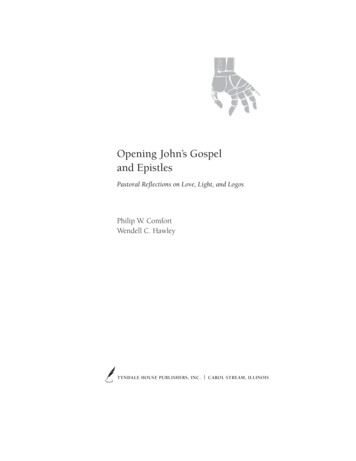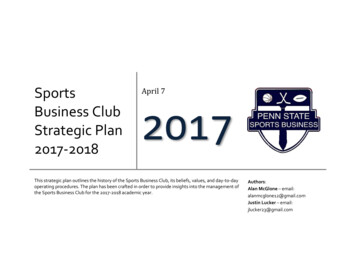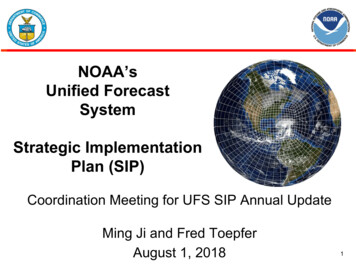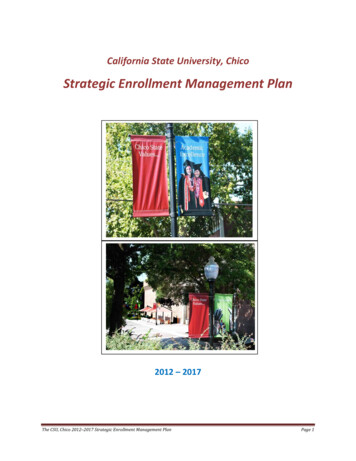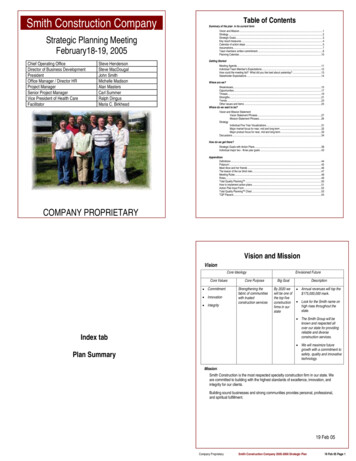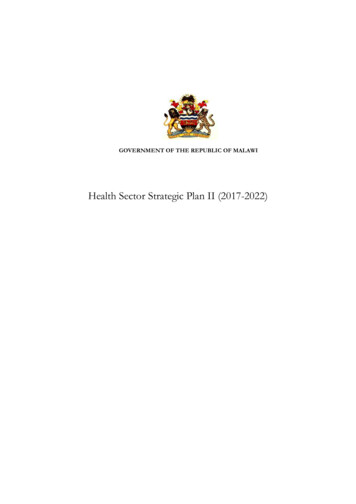![[2017-2021 STRATEGIC PLAN ] - John Bel Edwards](/img/25/20172021lasubstanceabusepreventionstrategicplan.jpg)
Transcription
[2017-2021 STRATEGIC PLAN]VISIONTo recognize that alcohol, tobacco, and other drug abuse is a serious social andpublic health issue that when addressed will create a climate of healthiness andcommunity wellness for all of Louisiana.MISSIONTo develop a comprehensive prevention framework system for the state ofLouisiana that will utilize partnerships across state government agencies,private sector agencies, and local communities to implement programs,practices, and policies identified as evidence-based strategies tomake impactful change in substance abuse prevention.
[2017-2021 STRATEGIC PLAN]Table of ContentsExecutive SummaryIntroductionBackgroundDefinition of PreventionHistory of PreventionPrevention Systems InfrastructureDrug Policy BoardPrevention Systems CommitteeState Epidemiology WorkgroupCommunity CoalitionsState Technical Assistance & Resource Staff (STARS)Advisory Council on Heroin and Opioid Prevention and EducationOrganizational Support ChartLouisiana Department of Health/Office of Behavioral HealthCosts of Substance Abuse PreventionCurrent Grants and ProgramsPrevention PartnersStrategic Plan Monitoring and ReviewSEW Online Data SystemNational Data SourcesLouisiana Data SourcesData InfrastructureNeeds Assessment DataHigh Risk PopulationsState Epidemiology Workgroup Data PrioritizationPriority of Geographic AreasNeeds Assessment Challenges and Data GapsCross-Cutting IssuesSustainabilityCultural CompetencyUnderage DrinkingService DisruptionLegislationNext StepsConclusionAppendicesA. Louisiana Substance Abuse Prevention Strategic Plan AcronymsB. Data Collection, Analyses, Evaluation and Reporting Action PlanC. Coordination of Prevention Services Action 4646474849505152525455
[2017-2021 STRATEGIC PLAN]D.E.F.G.H.I.J.K.L.M.N.O.Training and Technical Assistance Action PlanBehaviors Action PlanIllicit Drugs Indicator OverviewAlcohol Indicator OverviewTobacco Indicator OverviewPrescription Drugs Indicator OverviewOpioid Indicator OverviewIllicit Drug Parishes Ranked Highest to LowestAlcohol Parishes Ranked Highest to LowestTobacco Parishes Ranked Highest to LowestPrescription Drug Parishes Ranked Highest to LowestOpioid Parishes Ranked Highest to Lowest565758616466687074788286
[2017-2021 STRATEGIC PLAN]Executive SummaryThe problems associated with substance abuse adversely affect millions of individuals dailyacross the United States. In Louisiana, a core team of key advisors from multiple state agencieshave served as the management team charged with providing oversight and direction for theimplementation of the State’s current Strategic Plan. Louisiana’s updated Strategic Plan (20172021) comprehensively and clearly outlines the goals and objectives identified to support andenhance the ongoing efforts to reduce substance abuse throughout the State over the next fiveyears. Louisiana’s substance abuse prevention professionals and their colleagues have developedthis document as a continuation of the work that was done in the previous Strategic Plan. TheState has a robust substance abuse prevention system and infrastructure with a cohort ofprofessionals that are equipped to support and address the needs of Louisiana’s localcommunities as it relates to substance use trends.Louisiana has been very fortunate to have many statewide agencies, private agencies, and otherpartners in substance use prevention. These partners have worked collaboratively through sharedresources, and, most importantly, ensured that services were not duplicated when addressingsubstance abuse prevention. The data for Louisiana continues to show the need for substanceabuse prevention as youth consistently report higher alcohol use rates than the nation regardlessof incidence of lifetime use (ever used in your lifetime), past 30 day use, or binge drinking (5 ormore drinks in a row during the past 2 weeks). Usage rates for youth in Louisiana exceedednational rates in 8th, 10th, and 12th grades according to the Monitoring the Future Survey. Forinstance, in 2016, youth in Louisiana reported rates of 14.1% for 30-day alcohol use compared tothe national rate of 7.3%. Binge drinking was reported at 7.8% compared to the national rate of3.4%.The objectives identified in this Strategic Plan will support strategies to effectively addresssubstance abuse prevention in the state. Topic-specific “mini” action plans have been created andare integrated in the overall Strategic Plan. These plans outline the steps to be used to close thegaps in our substance abuse prevention system. The expectation is to move the needle insubstance abuse prevention through the implementation of these action plans. The topic-specificareas are: 1) Data Collection, Evaluation, and Reporting; 2) Coordination of Prevention Services;3) Training and Technical Assistance; and 4) Behavioral (Alcohol, Tobacco, Illicit Drugs,Prescription Drugs, and Opioids). Agency members of the Prevention Systems Committee andthe State Epidemiology Workgroup - subcommittees of the Drug Policy Board - are essentiallyresponsible for the implementation of the Louisiana Substance Abuse Prevention Strategic Plan.The Plan provides a roadmap for addressing substance abuse prevention in Louisiana. TheLouisiana Substance Abuse Prevention Strategic Plan is a fluid document and adjustments willbe made as needed outline throughout the five-year process.3
[2017-2021 STRATEGIC PLAN]IntroductionLouisiana will focus on the implementation of a five-year comprehensive strategic plan toaddress substance abuse prevention. This is the next step to continue building upon successesachieved through previous funding and current sources and coordinated support from state andfederal sources.In order to update the previous Strategic Plan, the current State substance abuse preventionsystem, accomplishments, gaps in services, and new trends in substance abuse were reviewedand considered. The explicit goals of the Center for Substance Abuse Prevention (CSAP) at theU.S. Department of Health and Human Services, Substance Abuse and Mental Health ServicesAdministration (SAMHSA) for the Partnerships for Success program were to reduce substancemisuse and strengthen the prevention capacity at the state, local, and tribal levels. Thus, the stateof Louisiana was able to maintain its focus on these four major topics identified under previousfederal grant programs: 1) Data Collection, Analysis, Evaluation, & Reporting; 2) Coordinationof Services; 3) Technical Assistance and Training; and 4) Behavioral. The Action Plans outlineand identify steps that Louisiana will take to further build infrastructure as well as close gaps inour substance abuse prevention system over the next five years. Furthermore, Louisiana commitsto upholding the principles of maintaining cultural competency and addressing high-riskpopulations.BackgroundThe Drug Policy Board (DPB), the State Epidemiology Workgroup (SEW), and the PreventionSystems Committee (PSC) convene quarterly throughout the year to provide guidance anddirection on the development of Louisiana’s Strategic Plan for Substance Abuse Prevention. TheDPB, members of the SEW, and members of the PSC represent state agencies, organizations, anduniversities that have a vested interest in the prevention of substance use and abuse in Louisiana.The Louisiana Department of Health/Office of Behavioral Health (LDH/OBH) and the Office ofthe Governor have jointly provided management and oversight of several prevention planninggrants including the State Incentive Grant (SIG), the Strategic Prevention Framework-StateIncentive Grant (SPF-SIG), the Strategic Prevention Framework-State Prevention Enhancement(SPF-SPE) Grant, and the current Strategic Prevention Framework-Partnerships for Success(SPF-PFS) Grant with a core team of key advisors. These advisors represent multiple stateagencies, including Louisiana Department of Education, Louisiana Highway Safety Commission,Southern University-BR, and the Louisiana Center Addressing Substance Use in CollegiateCommunities at Louisiana State University. This team serves as the Strategic PreventionFramework Management Team and provides direction as it pertains to the implementation ofLouisiana’s Strategic Plan for Substance Abuse Prevention and the future of substance abuseprevention in Louisiana.4
[2017-2021 STRATEGIC PLAN]The SPF-SPE grant was timely for the state of Louisiana as implementation of the SPF-SIGgrant was finalized in September, 2011. The SPF-SPE funding resource was designed to helpstates, regions, and districts develop a strategic plan to guide the administration and theadvancement of prevention services which led to the creation of the Louisiana 2012-2016Strategic Plan. Since then, the SPF-PFS funding resources have supported the implementation ofthe 2012-2016 Strategic Plan as well as provided the capacity to develop this 2017-2021 Plan.Definition of PreventionPrevention is the proactive outcome-driven process of promoting healthy lifestyles andimproving quality of life by empowering individuals, families, and communities through anintegrated system of evidence-based policies, programs and practices. Ideally, prevention isintended to prevent or reduce the risk of developing a behavioral health problem such asunderage drinking, prescription drug misuse and abuse, and illicit drug use. Early intervention isthe key to preventing the onset of substance abuse usage issues. Community involvement is vitalto ensure that the issue of prevention is being tackled at every level. It is our belief thatprevention works. Furthermore, it provides hope for effecting change to support healthybehaviors.History of PreventionSubstance abuse prevention is a continuously evolving field. Once the province of grassrootsstrategies providing only anecdotal evidence of effectiveness, today’s field is dominated byreplicable evidence-based programs, policies, and practices with demonstrated effectiveness.In the early days of research-based prevention, Louisiana’s focus was on individuals. Guided bythe risk and protective factor model, prevention efforts targeted the attitudes and behaviors ofyouth and primary caregivers toward the use of alcohol, tobacco, and other drugs. Schools andcommunity-and faith-based organizations worked with targeted populations usingSAMHSA/CSAP’s six strategies: information dissemination, education, alternative activities,community-based process, environmental strategies, and problem identification and referral.Most early prevention efforts, however, neglected environmental factors and community-basedprocesses, focusing instead on protecting the individual through educational efforts, informationdissemination, and alternative activities (e.g., afterschool programs), with the expectation thateducating youth on the risks associated with alcohol, tobacco, and other drugs (ATOD) would besufficient to prevent and avoid problems. What we found, however, was that these individualisticefforts often were not as effective as expected. A young person who attended a well-presentededucation seminar on prevention at school might go home to a neighborhood where use wasglamorized on billboards, laws were not enforced, and alcohol, tobacco, and other drugs wereplentiful.5
[2017-2021 STRATEGIC PLAN]Researchers in the prevention field began to look at what worked and what did not, testing andreplicating prevention strategies with diverse populations to identify those that were effective inpreventing substance abuse. The picture of prevention that emerged was of a complex andmultifaceted process. It became clear that to be most effective, prevention efforts needed tobroaden their focus to target population-level change. Addressing the environment, socialstructure, and the distribution of resources will ultimately produce measureable improvements inharmful consumption patterns and negative consequences in the targeted population. Thisexpanded framework, known as the public health approach, can reduce substance use and relatedconsequences by focusing on preventing health problems and promoting healthy living for wholepopulations of people.During the last 15 years, the state of Louisiana under the guidance of SAMHSA/CSAP hasadopted this more comprehensive approach. We continue to use evidence-based programs,policies, and practices that change behaviors, attitudes, and perceptions toward substance use andabuse among targeted populations, but also expanding our focus to include strategies that changethe environment in which these behaviors, attitudes, and perceptions occur.The SPF model was adopted by the Drug Policy Board to guide substance abuse preventionplanning in the state. Prevention efforts in the past used the risk and protective factor model,which focused on variables that predict - and potentially lead to – substance use. These keycomponents highlight the SPF as an outcome-based model. The SPF steps are formally referredto as 1) Assessment; 2) Capacity; 3) Planning; 4) Implementation; and 5) Evaluation.Sustainability and Cultural Competence are considered cross-cutting components. This modelgives communities the ability to assess needs and resources, builds capacity to adequatelyaddress needs, effectively plan and implement strategies for the identified needs, and evaluateefforts for improving future prevention.SAMHSA’s StrategicPrevention Framework (SPF)www.samhsa.gov6
[2017-2021 STRATEGIC PLAN]Prevention Systems InfrastructureDrug Policy BoardThe Drug Policy Board, which was legislatively created in 1990, under Louisiana RevisedStatute 49:219:1-4 to address substance abuse prevention, treatment, and enforcement,positioned Louisiana to be one of twenty states in the first cohort of SPF-SIG funding. Louisianaimplemented the SPF-SIG according to the expectations put forth by CSAP, the funding agencywithin SAMHSA. The project was identified during that time period as, “The Governor’sInitiative to Build a Healthy Louisiana.” Louisiana fully embraced CSAP’s concept that it is thestate’s responsibility to develop a substance abuse prevention system and state infrastructure thatsupports communities in addressing substance abuse issues on a local level. Therefore, duringSPF-SIG funding, the Drug Policy Board (DPB) institutionalized the State EpidemiologyWorkgroup (SEW) and Prevention Systems Committee (PSC) as subcommittees of the DrugPolicy Board and formalized both within the Drug Policy Board Bylaws.The following are excerpts from the enacted Drug Policy Board legislation and board bylaws,respectively:§219.1. Policy and purposeA. It is the policy of the state to undertake every responsible effort, explore everyopportunity, invite every useful contribution, and expend every available resource, toeliminate the abuse of drugs and alcohol and the damage to people and institutionsthat results from such abuse.B. In view of the policy of the state, it is the purpose of this Part to establish a stateagency organizationally positioned and structurally empowered to elicit, motivate,and coordinate the best efforts and ideas of all organizations, agencies, entities, andindividuals who volunteer or can be conscripted to make a contribution toward thegoal of eradicating drug and alcohol abuse and its poisonous fruit.The following list is representative of participating agencies on the DPB:District Court JudgeGovernor’s Office, Office of Drug PolicyLouisiana Board of PharmacyLouisiana Commission on Law EnforcementLouisiana Department of Children & Family ServicesLouisiana Department of Education, Healthy Communities SectionLouisiana Department of Health, Office of Behavioral HealthLouisiana Department of Public Safety & Corrections, Louisiana State PoliceLouisiana Department of Public Safety & Corrections, Louisiana Highway SafetyCommissionLouisiana Department of Veteran AffairsLouisiana District Attorney’s AssociationLouisiana House of Representatives, Health and Welfare Committee MemberLouisiana Senate, Health and Welfare Committee MemberLouisiana National GuardNew Orleans Health Department7
[2017-2021 STRATEGIC PLAN]Louisiana Department of Revenue, Office of Alcohol and Tobacco ControlLouisiana Department of Justice, Office of the Attorney GeneralPrivate Organization Involved in Substance Abuse PreventionRepresentative from the Alcohol IndustrySubstance Abuse and Mental Health Services AdministrationARTICLE VI CommitteesSection 1: The Prevention Systems Committee (PSC) is created as a state level advisorycommittee of the Drug Policy Board. The purpose of this Committee is to makerecommendations regarding effective programs, policies, and practices regardingresource and capacity issues, as well as develop a framework to build an advocacynetwork for prevention.Section 2: The State Epidemiology Workgroup (SEW) is created as a state level advisorycommittee of the Drug Policy Board. The purpose of this Committee is to advise andmake recommendations on issues related to collecting, housing, analyzing, and reportingconsumption and consequence data related to substance use.Prevention Systems CommitteeThe Prevention Systems Committee (PSC) is a subcommittee of the DPB and is a state-leveladvisory group of prevention stakeholders who make recommendations to the DPB regardingeffective programs, policies, and practices for substance abuse prevention. The PSC supports aframework that builds capacity to mobilize state, regional, and community systems in order toaddress needs identified by data and to implement evidence-based strategies to reduce substanceabuse and its related consequences. This framework requires policy changes that supportincreased capacity in workforce development, criteria for coalitions, and identification andselection of evidence-based and culturally appropriate interventions. The PSC utilizescommunication plans to increase awareness and opportunities for collaboration across multipleagencies and stakeholders. The PSC also promotes interagency agreements and collaborationamong key prevention agencies, compiles and communicates information regarding preventionresources, and supports the assessment of community readiness to address substance-relatedproblems. The PSC will work with the DPB to coordinate programs, policies, and practicesthroughout the implementation of Louisiana’s Strategic Plan for Substance Abuse Prevention.Membership of the PSC is aligned with the membership of the DPB. The SPF process isenhanced when implemented through a functioning coalition. The PSC was formed with thepurpose of serving as the state coalition for substance abuse prevention. There are currently 27individuals representing multiple agencies, universities and organizations who serve as membersof the PSC. Some members are designated as full PSC members who possess voting privileges,while other individuals are considered “of counsel” members who are invited to attend meetingsand participate, but who do not have voting privileges. The PSC addresses prevention prioritiesfor the state based on data and coordinates prevention services delivered by the memberagencies.The PSC is institutionalized within the DPB bylaws with meetings currently being held on aquarterly basis. Members serve terms concurrent with the governor and enter into Cooperative8
[2017-2021 STRATEGIC PLAN]Involvement Agreements which detail member roles and responsibilities. The work of the PSC isguided by formalized bylaws. In the event that there is a need to expand participation or fillvacancies, active recruitment and outreach is conducted. Once identified, new members areprovided orientation of past prevention efforts particularly as it pertains to the strategic planningprocess.State Epidemiology WorkgroupThe State Epidemiology Workgroup (SEW) has been tasked with identifying, collecting,analyzing, and disseminating consumption and consequence data related to substance use that isavailable from state and national data sources, and prioritizing available data for substance abuseprevention needs. The initial work of the SEW focused on the collection of substance abuserelated data toward the aim of developing a state epidemiological profile report. The reportincluded consumption indicators and long term and short term consequence indicators at the stateand community level. During the initial years of the SEW’s existence, a key to the success of theSEW was the facilitation of interagency collaboration to encourage data sharing and technicalassistance among multiple state agencies. As data sharing became more institutionalized, theSEW turned its attention to data analyses and interpretation, as well as policy issues regardingdata.The SEW reports directly to the DPB on the ongoing progress toward the implementation of theaction plan, makes recommendations regarding improvements in data collection, andcontinuously work to fill data gaps in order to improve the quality, sufficiency and integrity ofthe data. The SEW works with the DPB to make recommendations on data system designfeatures, which include policy changes and technology needed to support sharing and using dataacross state systems, organizations, and communities. Furthermore, the SEW fully supports theregional-based epidemiology efforts to support local level data-driven decision making.The SEW membership has evolved over the years as the goals and activities of the SEW havechanged due to trends in substance use. There are currently 24 individuals representing multiplestate agencies, universities, and organizations who serve as members of the SEW. Somemembers are designated as full SEW members who possess voting privileges, while otherindividuals are considered “of counsel” members who are invited to attend meetings andparticipate, but who do not have voting privileges. The SEW is institutionalized within the DPBbylaws with meetings currently being held on a quarterly basis. Members serve terms concurrentwith the governor and enter into Cooperative Involvement Agreements which detail member’sroles and responsibilities. In the event that there is a need to expand participation or fillvacancies, active recruitment and outreach is conducted through the SEW membershipsubcommittee. Once identified, new members are provided orientation of past prevention effortsparticularly as it pertains to the strategic planning process.Community CoalitionsCommunity Coalitions function efficiently with multi-sector representation that also sharetargeted outcomes and goals. These coalitions would have a vested interest in preventingsubstance use and have a voice for programs and policies in the state of Louisiana. Often times,we realize that individuals and/or agencies work in silos which lead to duplication of servicesand resources. It is imperative that we find a way to communicate, network, coordinate,9
[2017-2021 STRATEGIC PLAN]cooperate, and collaborate to effectively align resources to address substance use. This would inturn lead to organized community efforts from coalitions. The network of coalitions funded bythe federal government, local governing entities, school districts, and parishes has helped toadvocate for more coalition work at the local level.State Technical Assistance & Resource Staff (STARS)The state of Louisiana immediately recognized the need to develop a technical assistance andtraining system to support the integration of the SPF process statewide. Therefore, the StateTechnical Assistance and Resource Staff (STARS) team was established. STARS is an existingcadre of state and university staff trainers who are knowledgeable and experienced in theimplementation of the Strategic Prevention Framework (SPF). The SPF is a five-step process tocomprehensively plan, implement, and evaluate prevention problems. The STARS team wasdeveloped to provide training and technical assistance in the application of the SPF planningprocess. The Governor’s Office, Louisiana Department of Health/Office of Behavioral Health,and Southern University-BR staff currently serves as members of the STARS team. STARS willcontinue to expand to include a larger cadre of multi-agency skilled professionals to providetraining and technical assistance to community coalitions.Advisory Council on Heroin and Opioid Prevention and EducationDuring the 2017 Regular Legislative Session HB 490, now known as Act 88 and authored byState Representative Walt Leger, III, was signed into law. It requires the Drug Policy Boardwithin the Office of the Governor to establish an Advisory Council on Heroin and OpioidPrevention and Education to coordinate resources and expertise to assist in a statewide response.The Advisory Council is responsible for establishing an Interagency Heroin and OpioidCoordination Plan.The plan shall include the following listed below:Parish-level data on opioid overdoses and the dispensing of overdose-reversal medicationProgress of current initiatives in the state relating to the heroin and opioid epidemicSpecific impacts to agencies in addressing education, treatment including the use ofmedication-assisted treatment, prevention, overdose, and recoveryThe Interagency Heroin and Opioid Coordination Plan is expected to be submitted annually tothe DPB, Governor, president of the Senate, speaker of the House, and chief justice of theLouisiana Supreme Court at the end of each calendar year.In addition to establishing a Coordination Plan, the Council will coordinate parish-level data onopioid overdoses and usage of overdose-reversal medication to support accurate statewide datawhich is critical in educating both those involved in policy development and the citizens of thestate. Also, the Council will coordinate a central online location to disseminate information andresources.10
[2017-2021 STRATEGIC PLAN]Organizational Support ChartLouisiana DrugPolicy rkgroupCommunityCoalitionsAdvisory Council onHeroin &Opioid Prevention &EducationState TechnicalAssistance &Resource StaffLouisiana Department of Health/Office of Behavioral HealthThe Office of Behavioral Health (OBH) within the Louisiana Department of Health (LDH) is thedesignated Single State Authority (SSA) for substance abuse services in Louisiana through thefederal Substance Abuse and Mental Health Services Administration. As such, OBH monitorsand manages the Substance Abuse Prevention and Treatment (SAPT) Block Grant funds for thestate which includes an allocation of 20 percent from this funding for prevention.Act 373, passed during the 2008 Louisiana Legislative Session, requires that all regions whichconvert to a local governing entity must successfully complete a readiness criteria process thatdemonstrates capability to assume the responsibility for high-quality service delivery and goodgovernance; in part by meeting requirements of the SAPT block grant. This process involves theestablishment of local governing boards that provide ongoing support and advice to theregional/district administrators while serving as vehicles for community coordination. Membersof the governing boards are appointed by the Governor from a list of qualified candidates basedon local recommendations, and the bylaws require that membership is reflective of thepopulation of the region/district. The regions/districts are staffed by state employees, most ofwho are involved in the provision of direct services. Services within the regions/districts are alsoprovided by public or private nonprofit organizations. OBH solicits proposals from theseorganizations for services. Awards are made by the Louisiana Department of Health based on therecommendations of an evaluation team at OBH in consultation with the appropriateregional/district office.During the 2009 Louisiana Legislative Session, Act 384 authored by State Representative FredMills and Senator Michael A. Walsworth was created. This legislation authorized theconsolidation of the administrative and planning functions of the Office of Mental Health(OMH) and the Office for Addictive Disorders (OAD) into a newly functioning Office ofBehavioral Health (OBH) within the Louisiana Department of Health.11
[2017-2021 STRATEGIC PLAN]The Office of Behavioral Health (OBH) was created on July 1, 2010 and represents a merger ofthe State’s mental health and addiction services into a single, integrated system of care. OBH hasunified its programs and administrative functions, supporting both the transition of LocalGoverning Entities (LGEs) to a unified behavioral health service setting, and the integration ofbehavioral health care services with primary care services in the state’s Medicaid program.In 2012, LDH/OBH moved to the provision of services through a Statewide ManagementOrganization (SMO) which was responsible for building a network of highly qualified providersthroughout the state, providing training to providers, and authorizing services for those referredto treatment. In December 2015, specialized behavioral health care services were integrated intothe State’s Medicaid Managed Care program known as Bayou Health. Bayou Health iscomprised of five managed care organizations (MCOs) which coordinate physical and behavioralhealth care services for over 919,000 Medicaid recipients, including adults with disabilities whodo not receive Medicare, children under age 19, their parents and pregnant women. Medicaidrecipients not covered in MCOs include nursing home residents, Medicare dual eligible andrecipients enrolled for some specialty service Medicaid programs. Individuals who receive homeand community based services are not automatically enrolled but may voluntarily opt in to ahealth plan. Individuals not enrolled in Bayou Health continue receiving care through the legacyfee-for-service system. As a result of these changes, substance use services have increasedsignificantly. In addition, there has been a strong emphasis on implementing evidence based andculturally sensitive practices in the treatment of individ
Louisiana that will utilize partnerships across state government agencies, private sector agencies, and local communities to implement programs, . C. Coordination of Prevention Services Action Plan 55 [2017-2021 STRATEGIC PLAN ] D. Training and Technical Assistance Action Plan 56 E. Behaviors Action Plan 57 .
